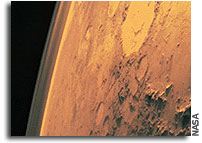Microbes Survive a Mixed Bag of Mars Biocidals

For the first time, scientists find that microbes from Earth can survive and grow even in the mix of drastically low pressure, freezing temperatures and oxygen-starved conditions seen on Mars.
In recent years, scientists have discovered many life forms on Earth capable of surviving extremes of heat, cold, radiation, dryness, acidity and numerous other trying conditions. These “extremophiles” raise the possibility that alien life might dwell in similarly harsh environments on distant worlds.
However, until now, the lowest atmospheric pressure that researchers could grow bacteria in was just 25 millibars. Although that is a little more than 2 percent of the average 1,013-millibar atmospheric pressure seen at sea level on Earth, it still is nearly four times greater than the 7-millibar global average surface pressure of Mars.
To test the extremes to which life on Earth may prosper, microbiologists Wayne Nicholson and Andrew Schuerger at the University of Florida and their colleagues analyzed microbes found in four samples of permafrost soil collected from northeastern Siberia by the Soil Cryology Laboratory in Russia. The lab has collected permafrost on annual drilling expeditions via helicopter or boat to the Arctic and Antarctic for the past 30 years or so.
These microbes, recovered by boring 40 to 70 feet (12 to 21 meters) into frozen soil, were grown for up to 28 days in nutrient-rich lab dishes at room temperature and normal air and pressure. Roughly 10,000 colonies of these bacteria were then incubated for an additional 30 days in a chamber designed to simulate the surface of Mars, keeping them at a freezing temperature of 32 degrees Fahrenheit (0 degrees Celsius) without oxygen at a pressure of 7 millibars.
Six colonies of bacteria grew under these severe conditions.
“For the first time, we know that at least some terrestrial microorganisms are capable of growth at the kind of pressure you find on Mars,” Schuerger said.
Genetic analysis revealed these were all strains of bacteria that belonged to the genus Carnobacterium.
“Carnobacterium is naturally found in permafrost, and is also a common contaminant of frozen meat,” Schuerger said. Nicholson, Schuerger and their colleagues Kirill Krivushin and David Gilichinsky detailed their findings online Dec. 24 in the journal Proceedings of the National Academy of Sciences.
In a companion study, Schuerger, Nicholson and their colleagues investigated 26 strains of bacteria commonly found on spacecraft, incubating them under the same Mars-like conditions. They found one bacterium, Serratia liquefaciens, could survive and grow. While Carnobacterium is specialized to live in the cold, Serratia liquefaciens is a generalist that colonizes and proliferates in a wide range of ecosystems, from human skin and the respiratory systems of animals to soils, plant surfaces and both freshwater and marine environments.
“We show that even microorganisms that might not have specialized to live in harsh conditions might nevertheless persist on Mars, so in the future, researchers who want to learn more about life on other planets should not only look at extremophiles, but many non-extremophiles as well,” Schuerger said. He, Nicholson and their colleagues Richard Ulrich and Bonnie Berry detailed their findings online Jan. 7 in the journal Astrobiology.
It remains uncertain why these microbes can survive and grow in extremely low-pressure conditions they would never naturally face at home. In fact, Carnobacterium apparently grew better without oxygen and low pressure than it did with oxygen and normal pressure.
“What we think is happening is that low pressure may be relaxing other inhibitions within the cells caused by low temperature or anoxic — low-oxygen — conditions,” Schuerger said. “It appears that at low pressures, an unknown mechanism might kick in that helps them increase the range in which they can grow.”
The researchers do caution that while they grew these bacteria under extremely low pressure, temperature and oxygen levels, “they were also grown in a wet, nutrient-rich environment,” Schuerger said. “These are conditions that are very difficult to meet on the surface of current-day Mars.”
For instance, if one were to imagine a 0 to 100 scale when it comes to how much moisture bacteria need to grow, the bacteria tested in both studies would generally require a 90, while Mars is by comparison a 10 or a 5. Even if there were carbon and nitrogen sources on Mars to act as nutrients, desiccation is always a threat due to the extreme aridity of the red planet’s surface, Schuerger said. As such, these experiments do not perfectly match the actual conditions microbes on Mars would face.
Still, these findings “open up much more complex experiments that scientists would not have been able to tackle before because we did not know if anything could grow at 7 millibars,” Schuerger said. “There are 17 ‘biocidal’ factors on the surface of Mars that might kill microbes there, and now we can test more of these factors simultaneously in experiments, such as severely dry conditions and high salt concentrations, to see if these affect microbial growth.”
Such research may also help scientists protect Mars from contamination by Earth bacteria.
“When we launch spacecraft to Mars, we want to make sure we don’t contaminate landing sites,” Schuerger said. “We want to make sure that any microbes that we detect on Mars are Martian microbes, not Earth bacteria.”
Understanding the extremes in which Earth bacteria can grow could help design ways to sterilize spacecraft before they go to Mars, or to identify locations on Mars that are at the most risk of contamination.
The researchers will now look at metabolic processes and cellular functions in these bacteria to figure out how they can grow in these extreme conditions.
“If we can understand the cellular mechanisms by which these organisms can grow under simulations of the Mars environment, this could give us clues as to how potential Martian life deals with its home environment,” Nicholson said.
“Hopefully a year from now, we’ll have more answers,” Schuerger said.
Charles Q. Choi, Astrobiology Magazine Contributor









